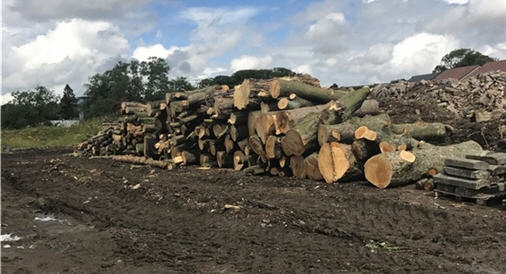Information About Tree Preservation Provided by Arborist Jim Petrie of Ptree Surgery and Groundworks St Andrews Fife
Trees in a conservation area that are not protected by an Order are protected by the provisions in section 211 of the Town and Country Planning Act 1990 These provisions require people to notify the local planning authority, using a 'section 211 notice' six weeks before carrying out certain work on such trees, unless an exception applies. The work may go ahead before the end of the six week period if the local planning authority gives consent. This notice period gives the authority an opportunity to consider whether to make an order on the tree
Getting Help With you Tree Preservation Application
Jim Petrie at Ptree Surgery and Groundworks can take care of your application , call us today to discuss your application
Frequently Asked Questions About Tree Preservation
1. What is a tree preservation order?
It is a written order made by a local planning authority (e.g. a borough, district or unitary council or a national park authority) which, in general, makes it an offence to cut down, top, lop, uproot, wilfully damage or wilfully destroy a tree protected by that order without the authority’s permission.
2. What is the purpose of a tree preservation order?
To protect trees which bring significant amenity benefit to the local area. This protection is particularly important where trees are under threat.
3. What type and species of trees can a tree preservation order protect?
All types, but not hedges, bushes or shrubs. An order can protect anything from a single tree to all trees within a defined area or woodland. Any species can be protected, but no species is automatically protected by a tree preservation order.
4. How can I find out if a tree is protected by a tree preservation order?
Contact the local planning authority. Details of tree preservation orders will be available for inspection at its offices.
An official search of the local land charges register can also be made before you buy a property. This should reveal the existence of an order and whether a property is in a conservation area (see question 18). Make sure your legal adviser tells you if any trees are protected.
5. If I see work being carried out on a protected tree, how can I find out if the owner has permission?
Check with the local planning authority, which will have a register of applications and decisions that you can look at.
6. There are trees which I think should be protected by a tree preservation order. What can I do?
Contact the local planning authority, giving details of the trees and the reasons why you think the trees should be protected.
7. When does a tree preservation order come into effect?
Provisional protection comes into effect as soon as the local planning authority makes the order. The authority will then need to confirm the order to provide long-term protection.
8. How will I know when a local planning authority makes a tree preservation order?
The authority will write to those who may have a right to work on the tree, generally the tree owner and sometimes others, such as tenants and neighbours. Copies of new orders are also available for inspection at the planning authority’s offices.
9. How can I object to or express support for a new tree preservation order?
Write to the local planning authority within the period it allows for comment (usually 28 days), identifying the tree or trees in question and giving your reasons.
The authority will take your comments into account when deciding whether or not to confirm the order. The authority can also modify an order when it confirms it, for example to exclude some of the trees.
10. Does the local planning authority become responsible for looking after protected trees?
No. Owners remain responsible for trees covered by tree preservation orders, their condition and any damage they may cause. But the authority’s permission is usually required before any work is carried out to the trees (see questions 11-14).
The authority may be able to offer help and advice on how the trees should be managed.
11. What if I want to work on a tree covered by a tree preservation order?
Apart from special exceptions (see questions 13-15) you (or your agent) must seek permission from the local planning authority by submitting a standard application form to it. The form is available from the Planning Portal (www.planningportal.gov.uk) or the authority. It is important to clearly specify the work you want done and provide information to support your case (such as professional advice on the health of the tree and, in cases of alleged subsidence, professional evidence on the soil, the structure affected and the tree).
Before making an application you may find it helpful to consult a tree surgeon or arboricultural consultant to help you clarify what you need to do. Information on selecting a tree expert can be found at www.tree- care.info/findanarb.
You may also find it helpful to refer to the local planning authority’s website for information on tree protection in the local area.
12. Do I need a Forestry Commission felling licence to fell protected trees?
You do not need a licence to fell trees in gardens. However, for trees outside of gardens, you may need to apply to the Forestry Commission for a felling licence, whether or not they are covered by a tree preservation order.
You can find out more about felling licences from the Forestry Commission (see Further information at the end of this leaflet).
13. Do I always need the local planning authority’s permission to work on a tree covered by a tree preservation order?
Yes, except for:
1.1) cutting down trees in accordance with one of the Forestry Commission’s grant schemes, or where the Commission has granted a felling licence (see question 12);
2.2) cutting down or pruning a tree:
- which presents an urgent and serious safety risk – however you must give written notice (by letter or email) of the proposed work to the local planning authority as soon as practicable after the work becomes necessary;
- which is dead – however you must give at least five working days written notice (by letter or email) of the proposed work to the local planning authority;
- which is directly in the way of development that is about to start for which detailed planning permission has been granted (see questions 20 and 21);
- in a commercial orchard, or pruning fruit trees in accordance with good horticultural practice;
- to prevent or control a legal nuisance (you may find it helpful to check first with a solicitor);
- in line with an obligation under an Act of Parliament;
- or at the request of certain organisations listed in the regulations (see Further information at the end of this leaflet).
3.3) removing dead branches from a living tree
If you are in any doubt about what needs permission, check with the local planning authority (see question 14).
14. What happens if I carry out work on a protected tree without permission?
If you deliberately destroy a protected tree, or damage it in a manner likely to destroy it, you could be liable to an unlimited fine. You could also be fined if you cause or permit such work. Other offences can lead to fines of up to £2,500.
15. When will I have to plant a replacement tree?
You will have to replant:
1.1) if you cut down or destroy a protected tree:
- in breach of a tree preservation order, or
- because the tree is dead or dangerous;
2.2) if the local planning authority gives you permission to cut down a protected tree but makes replanting a condition of its consent;
3.3) in most cases where the Forestry Commission grants a felling licence.
Local planning authorities have legal powers to ensure that you plant a replacement tree when required.
16. What if my application to carry out work under a tree preservation order is refused, or I object to the conditions imposed by the local planning authority?
You can appeal to the Secretary of State for Communities and Local Government in writing within 28 days of receiving the local planning authority’s decision. The authority will give you the address. The Secretary of State may allow or dismiss the appeal, or vary the original decision.
Further information about tree preservation and tree replacement appeals is on the Planning Portal (www.planningportal.gov.uk).
17. Can I get compensation if my application to carry out work under a tree preservation order is refused or conditions are imposed?
In certain circumstances which are set out in the legislation (see Further information) you can seek compensation from the local planning authority for loss or damage which results from the authority refusing consent or granting consent with conditions. However, the legislation sets limitations and strict criteria that must be met. See question 11 regarding the need for adequate information to support your case.
Claims should be sent to the local planning authority within 12 months of its decision, or within 12 months of the Secretary of State’s decision if you appealed.
18. How are trees protected in a conservation area?
Normal tree preservation order procedures apply if a tree in a conservation area is already protected by a tree preservation order. But if a tree in a conservation area is not covered by an order, you have to give written notice (by letter or email) of proposed work to the local planning authority, describing what you want to do, at least six weeks before the work starts. This gives the authority an opportunity to consider protecting the tree with a tree preservation order.
You do not need to give notice of work on a tree in a conservation area less than 7.5 centimetres in diameter, measured 1.5 metres above the ground (or 10 centimetres if thinning to help the growth of other trees).
The answer to question 14 also applies to trees in conservation areas, so if you are not sure about what you should do, check with the local planning authority.
19. How are trees on development sites affected?
They can be protected by a tree preservation order or by a condition attached to a planning permission, or both. A planning condition may also require trees to be planted, which may then be protected by a tree preservation order.
20. Can I stop planning permission being granted – or prevent approved development being carried out – by getting a tree preservation order imposed on trees on the site?
No. A tree preservation order does not prevent planning permission being granted. But a local planning authority will consider the risk to protected trees when deciding planning applications.
Once detailed planning permission is granted, felling that is directly required to enable the development to go ahead may be carried out.
21. Can I carry out work on protected trees which are in the way of proposed development?
You can only cut down or cut back protected trees if they are directly in the way of development which is about to start and for which detailed planning permission has been granted.
If you have outline planning permission or if the development does not require planning permission (a small home extension, for example) you must still apply to the local planning authority for permission under the tree preservation order in the normal way.
If you are in any doubt about what is required, check with the local planning authority (see question 14).




